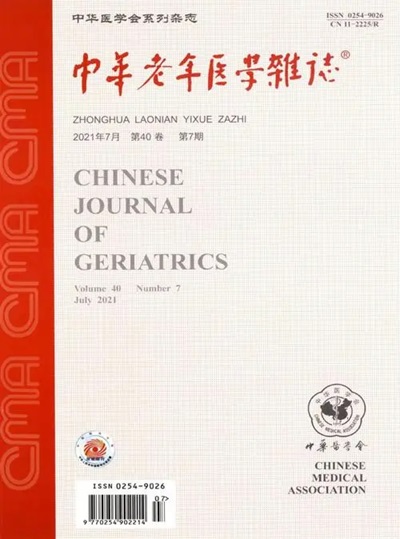Relationship between hemoglobin level and the prognosis of cerebral infraction in elderly patients aged 75 years and over
引用次数: 0
Abstract
Objective To investigate the relationship between hemoglobin levels and prognosis of cerebral infarction in elderly patients aged 75 years and over. Methods A retrospective analysis of 238 elderly patients (≥75 years old) with cerebral infarction admitted into our hospital from January 2016 to June 2018 was performed. The age, gender, serum creatinine and risk factors for stroke (hypertension, diabetes, dyslipidemia, homocysteine, atrial fibrillation, smoking, drinking), coronary heart disease, previous stroke history, tumor history, National Institutes of Health Stroke Scale (NIHSS) score, hemoglobin, hematocrit and other basic data were recorded. The patients were divided into the group with good prognosis (mRS score ≤ 2) and the group with poor prognosis (mRS score > 2). The relationship between hemoglobin levels and the prognosis of cerebral infarction in elderly patients were analyzed. Results After 6 months of follow-up, 124 (52.1%, 124/238) stroke patients had a good prognosis, and 114 (47.9%, 114/238) patients had a poor prognosis, including 21 deaths. Anemia at admission (OR=2.433, 95%CI: 1.213-4.591, P=0.011), new-onset anemia after hospitalization (OR=2.615, 95%CI: 1.333-6.521, P=0.043) and the low level of minimum hemoglobin during hospitalization (OR=0.847, 95%CI: 0.671-0.971, P=0.038) were independent risk factors for poor prognosis in elderly stroke patients aged ≥75 years. New-onset anemia after hospitalization (OR=1.015, 95%CI: 1.002-1.027, P=0.022), the low level of minimum hemoglobin during hospitalization (OR=0.801, 95%CI: 0.654-0.981, P=0.027), the decrement of hemoglobin ≥20 g/L (OR=1.342, 95%CI: 1.011-1.763, P=0.000) at reexamination were independent risk factors for the mortality in elderly patients with cerebral infarction. Conclusions Anemia at admission, new-onset anemia after hospitalization, and the low level of minimum hemoglobin during hospitalization are independent predictors for poor prognosis in cerebral infarction patients aged ≥75 years. The decrement of hemoglobin ≥20 g/L after admission is an independent predictor for high mortality in elderly patients with cerebral infarction. Key words: Brain infarction; Hemoglobinometry75岁及以上老年脑梗死患者血红蛋白水平与预后的关系
目的探讨75岁及以上老年脑梗死患者血红蛋白水平与预后的关系。方法对2016年1月至2018年6月收治的238例老年(≥75岁)脑梗死患者进行回顾性分析。记录年龄、性别、血清肌酐和卒中危险因素(高血压、糖尿病、血脂异常、同型半胱氨酸、心房颤动、吸烟、饮酒)、冠心病、既往卒中史、肿瘤史、美国国立卫生研究院卒中量表(NIHSS)分、血红蛋白、红细胞压积等基础数据。将患者分为预后良好(mRS评分≤2)组和预后不良(mRS得分>2)组。分析老年脑梗死患者血红蛋白水平与预后的关系。结果经过6个月的随访,124例(52.1%,124/238)脑卒中患者预后良好,114例(47.9%,114/238)患者预后不良,其中21例死亡。入院时贫血(OR=2.433,95%CI:1.233-4.591,P=0.011)、住院后新发贫血(OR/2.615,95%CI:1.333-6.521,P=0.043)和住院期间最低血红蛋白水平低(OR=0.847,95%CI:0.671-0.971,P=0.038)是75岁以上老年脑卒中患者预后不良的独立危险因素。住院后新发性贫血(OR=1.015,95%CI:1.002-1.027,P=0.022)、住院期间最低血红蛋白水平低(OR=0.801,95%CI:0.654-0.981,P=0.027)、复查时血红蛋白下降≥20g/L(OR=1.342,95%CI:1.011-1.763,P=0.000)是老年脑梗死患者死亡的独立危险因素。结论入院时贫血、住院后新发贫血和住院期间最低血红蛋白水平低是75岁以上脑梗死患者预后不良的独立预测因素。入院后血红蛋白下降≥20g/L是老年脑梗死患者高死亡率的独立预测因素。关键词:脑梗塞;血红蛋白测定
本文章由计算机程序翻译,如有差异,请以英文原文为准。
求助全文
约1分钟内获得全文
求助全文

 求助内容:
求助内容: 应助结果提醒方式:
应助结果提醒方式:


